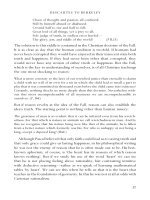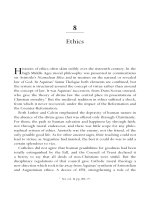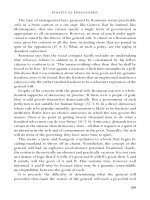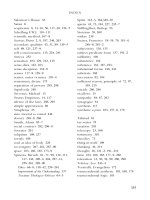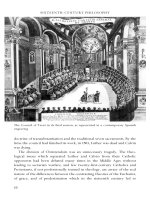The rise of modern philosophy a new history of western philosophy volume 3 (new history of western philosophy) ( PDFDrive ) (1) 24
Bạn đang xem bản rút gọn của tài liệu. Xem và tải ngay bản đầy đủ của tài liệu tại đây (21.59 KB, 1 trang )
SIXTEENTH-CENTURY PHILOSOPHY
the presence of Christ in the Eucharist and of the decrees through which
God chose the elect. Calvin, like Luther, placed the ultimate criterion of
religious truth within the individual soul: every faithful Christian experienced within himself a marvellous conviction of heavenly revelation which
was more reassuring than any reasoning could ever be. But how could one
tell who were faithful Christians? If one counted only the reformed, then
Calvin’s criterion was question-begging; on the other hand, if one counted
all those who had been baptized, it led to an anarchy of belief.
Protestants argued that the Church could not be the ultimate authority
because its claims rested on biblical texts. Catholics, quoting Augustine,
claimed that the only reason for accepting the Bible was that it had been
given us by the Church. The questions at issue in Europe at the Reformation were in the end settled neither by rational argument nor by interior
enlightenment. In country after country conXicting answers were imposed
by force of arms or by penal legislation. In England Henry VIII, irked by
Vatican refusal to free him from a tedious marriage, broke with Rome and
executed More for his loyalty to the pope. The country then lurched from
his schismatic version of Catholicism to Calvinism under his son Edward
VI, to Counter-Reformation Catholicism under his daughter Mary, and
Wnally to an Anglican compromise under her sister Elizabeth. This chequered history produced hundreds of martyrs, both Protestant and Catholic; but England was spared the sanguinary wars of religion which raged
for many decades in continental Europe.
By the mid-sixteenth century doctrinal positions had hardened into a
form that they were to retain for some 400 years. Luther’s lieutenant
Melancthon formulated at Augsburg in 1530 a confession of faith to
provide the test of orthodoxy. A concordat agreed in the same city in
1555 provided that the ruler of each state within the Holy Roman Empire
could decide whether his subjects were to be Lutheran or Catholic: the
principle later known as cuius regio, eius religio. Calvin’s Institutes of the Christian
Religion (1536) provided the standard for Protestants in Switzerland, France,
and later Scotland. In Rome Pope Paul III (1534–9) promoted a CounterReformation, instituting a new religious order of Jesuits, and convening a
Council at Trent to reform Church discipline. The council condemned the
Lutheran doctrine of justiWcation by faith alone, and the Calvinist doctrine
that God predestined the wicked to hell prior to any sin. Free will, it
insisted, had not been extinguished by Adam’s Fall. It reaYrmed the
9

